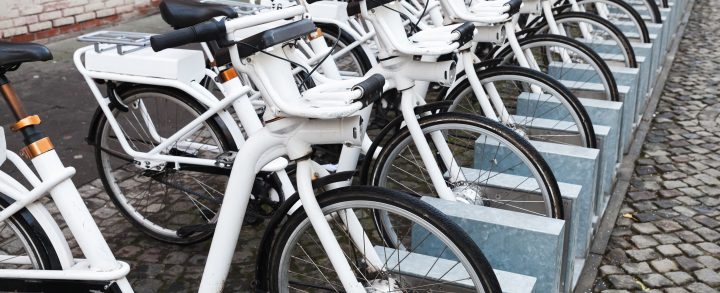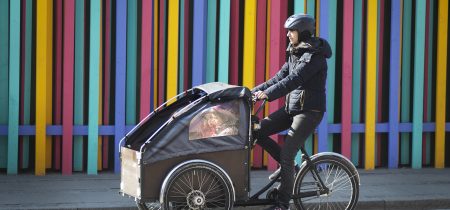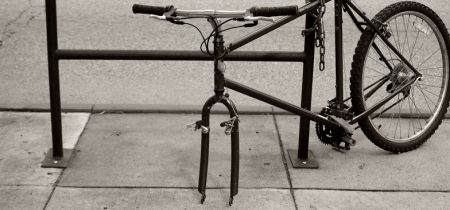The city bike and other bike-share schemes
In recent years, city bikes, commuter bikes and other forms of bicycle- sharing systems have spread to many cities all over the world. The systems are very different and target different groups.
By Lotte Malene Ruby, Danish Cyclists’ Federation
The world’s first city bike saw the light of day in Copenhagen in 1995. It was an extremely simple, robust bicycle, and it was free of charge. A refundable coin was used to unlock the bicycle from the docking station. The project was financed by advertising and managed by a fund backed by the City of Copenhagen. Its mission was to create a new, green transport option for the city’s citizens and tourists.
The original Copenhagen city bike was a unique idea implemented in practice. Admittedly, the bicycles were uncomfortable to ride, they were often vandalized or stolen, and the financial model was shaky. Nevertheless, the idea was so groundbreaking that the project quickly became known outside the country.
Although the original city bikes were far from flawless, the idea was copied and further developed in the following years, in other cities that wanted to give tourism an extra boost or provide new options for commuters, but also in cities whose objective was to create a new cycling culture virtually from scratch.
City bikes and commuter bikes in other Danish cities
In the years following 1995 city and commuter bikes were introduced in a number of Danish cities , including Aarhus, Aalborg, Frederikshavn, Assens and Odense. The schemes have had mixed results.
One challenge was to combine the need for a simple, robust bicycle with cycling comfort. The bicycles typically lacked elementary accessories such as baskets, gears, lights, and a locking system, which made the bicycles less attractive. Another disadvantage, especially for commuters, was that the bicycles were often only available during the summer months.
Experience shows that a well- run city bike system has a positive impact on the city’s image whereas, not surprisingly, a broken -down, outdated system has the opposite effect.
Today most of the original Danish city bike systems have been replaced with new models. In Copenhagen a brand new, advanced city bike system was introduced in 2012 using E-bikes.
However, the system was costly to develop and operate, and demand was lower than expected, so work continues on improving the model.
In Aarhus and Aalborg today, the original city bike systems have been replaced by new systems based on collaboration with the private Danish bike rental service, Donkey Republic, one of a number of private players that have given the original, municipally funded systems hard competition in recent years. The main difference is that no docking stations are needed for the new city bikes, which makes the system cheaper and more flexible. A city bike system can thus be established and removed from a city over a very short period of time.
City bikes in cities with very few bicycles
The larger Danish cities have always been characterized by a large number of cyclists whereas in the majority of foreign cities cyclists are an absolute minority. However, a growing focus on health, climate, the environment and accessibility have put a new focus on cycling, and bike share systems have become a means of introducing bicycles into cities without a strong cycling culture.
One of the first European cities to introduce city bikes with the aim of kick-starting cycling culture was the French city of Lyon. It launched a city bike system in 2006, which was also rolled out in Paris two years later. Both cities have been successful in encouraging many more of the city’s inhabitants and tourists to cycle and in getting citizens to invest in bicycles of their own. One reason for the system’s success is the low cost of renting the bicycles, which are equipped with locks, baskets and lights. Today there are more than 20,000 city bikes in Paris, distributed over considerably more than 1,000 docking stations.
However, there are still issues to be resolved, such as vandalism, and the fact that there are not always enough bicycles where the need is greatest. On the other hand, a sustainable financial model combining rental income with advertising funding has been developed.
Similar city bike systems can be found today in a large number of European cities including Stockholm, London, Brussels, Amsterdam, Barcelona, Hamburg and Vienna.
City bikes – with and without docking stations
City bikes have been typically linked to racks or docking stations located at strategic points around the city, where the bicycles could be picked up and left again after use. In recent years, however, a new type of city bike has become popular in many cities: city bikes without docking stations, also called “dockless”.
In Denmark many people have probably noticed the orange city bikes from the operator Donkey Republic, which has introduced its dockless bikes in many cities, both at home and abroad.
New GPS technology has made it possible to create a system where bicycles aren’t dependent on a docking station, but can be traced by either the company or the user by means of an app. The advantage for the user is that you can leave the bicycle wherever you like and if you’re lucky you can pick up a new bike anywhere in town.
However, the new dockless city bikes are also the subject of controversy since these are private companies competing with older, semi-public systems. The quality of the bicycles has also been criticized as well as the companies’ ability to manage their bicycles. In recent years several international operators have gone bankrupt or switched over solely to electric scooters.
In some cities, for example in China, dockless city bikes have become a real problem since even though the bicycles are very popular, enhance health and accessibility, and reduce pollution, there are simply too many operators around. In addition, users don’t always take very good care of the bicycles.
In many cities, altogether too many low quality city bikes are clogging the streets, and the operators do little to maintain and manage them. In the Chinese city of Xiamen, for example, the authorities had to intervene and collect thousands of vandalized city bikes that were obstructing traffic.
Another point of criticism, which equally applies to other modern transport systems, is that such systems make it possible to collect data on the users’ movements. Data has become a saleable commodity, and the question of its subsequent use is an issue that needs to be confronted as new systems and players enter the field.
On the other hand, there are also fine examples of dockless systems and the new players on the market. In Aarhus and Aalbog, for example, the authorities have entered into a collaboration with private players to supply city bikes to the two cities. Private companies in Denmark must have permission from the local authorities to rent out bicycles on public thoroughfares. Improved legislation is necessary to make it easier for the authorities to enforce this rule.
Other types of bicycle sharing systems
Company bikes are becoming an increasingly common sight at Danish workplaces. Companies and organizations, especially in the larger cities, have realized that the quickest means of transport to a meeting at another location in town, for example, is not necessarily by car.
Several companies today offer to supply company bikes bearing the company logo, and include service agreements so the bikes are always in great shape. Companies that make company bikes available to their employees are rewarded by healthy, green transport – and good company branding at the same time.
Today, Danish firms are not allowed to make company bikes available to their employees outside of working hours, otherwise the employee will be taxed. This places a limit on the use of the bicycles and it is in the interest of the companies to raise the issue.
A special type of bike share is the student bike. These are advertising funded bicycles that students can borrow for free. In return the student is committed to maintaining the bicycle, locking it responsibly, and using it as much as possible as long as he or she has it. When the student no longer needs the bicycle, it’s passed on to another student.
Bicycle leasing
Leasing a car instead of buying one has long been popular among drivers. In most Danish cities today you can also lease a bicycle. The advantage is that you don’t need to invest a large sum all at once, but simply pay a smaller monthly rate. Repairs are paid for by the company and are carried out as you wait, or you’re given a replacement. On the other hand, you have to accept the bicycle type provided by the company.
Swapfiets is an example of a company that leases out bicycles in the larger Danish cities and in a great many cities in the Netherlands, Belgium and Germany.
Bicycle Libraries
A bicycle library is a facility where you can borrow a bicycle, for example a cargo bike or an E-bike, if you would like to try out another type of bicycle than the one you normally ride. The basic idea is that practical experience is the way forward if people are to change their old habits or find new solutions.
For example, if you’re wondering whether to buy a cargo bike, which is certainly not cheap, it’s nice to be able to try out the concept first. Several Danish cities have – or had – public bicycle libraries. Here are four examples:
- Miljøpunkt Amager (http://miljopunkt-amager.dk/la%CC%8An-en-cykel/) in Copenhagen lends out cargo bikes.
- Horsens Cykelbibliotek (http://cykelby.horsens.dk/dk/horsens-cykelbibliotek/ ) lends out E-bikes.
- Cyklisternes By, Odense, lends out E-bikes, cargo bikes and bicycle trailers. (https://www.cyklisternesby.dk/voksne/laan-en-ladcykel )
- Aarhus Municipality has a mobile bicycle library in a container (http://www.smartmobilitet.dk/)





